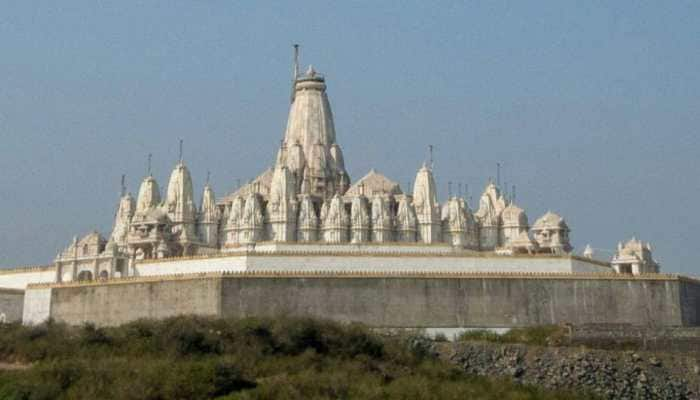All you need to know about 13 payloads of Chandrayaan 2
According to ISRO, 8 payloads will be on the orbiter, 3 on lander and 2 on rover. NASA's passive experiment will be carried by Vikram Lander.
Trending Photos
) Image Courtesy: ISRO
Image Courtesy: ISRO Chandrayaan 2, India's second lunar mission, was launched at 2:43 PM on Monday with 13 payloads and one passive experiment from American space agency NASA. According to ISRO, 8 payloads are on the orbiter, 3 on lander and 2 on rover. NASA's passive experiment is carried by Vikram Lander.
Orbiter payloads:
a. Terrain Mapping Camera - 2: TMC 2 is a miniature version of the Terrain Mapping Camera which was used during the Chandrayaan 1 mission. The main objective of TMC 2 is to map the lunar surface in the panchromatic spectral band (0.5-0.8 microns) with a high spatial resolution of 5 m and a swath of 20 km from 100 km lunar polar orbit. The data collected by TMC 2 will give us clues about the evolution of moon and play an important role in 3D maps of the lunar surface.
b. Chandrayaan 2 Large Area Soft X-ray Spectrometer (CLASS): CLASS measures the Moon's X-ray Fluorescence (XRF) spectra to examine the presence of major elements such as Magnesium, Aluminium, Silicon, Calcium, Titanium, Iron, and Sodium.
c. Solar X-Ray Monitor: XSM observes the X-rays emitted by the Sun and its corona, measures the intensity of solar radiation in these rays, and supports CLASS. The primary objective of this payload is to provide solar X-ray spectrum in the energy range of 1-15 keV.
d. Imaging IR Spectrometer: IIRS has two primary objectives, including global mineralogical and volatile mapping of the Moon in the spectral range of ~0.8-5.0 µm for the first time, at the high resolution of ~20 nm and complete characterisation of water/hydroxyl feature near 3.0 µm for the first time at high spatial (~80 m) and spectral (~20 nm) resolutions
e. Dual Frequency Synthetic Aperture Radar: The dual frequency (L and S) SAR will provide enhanced capabilities compared to Chandrayaan 1's S-band miniSAR in areas such as L-band for greater depth of penetration (About 5m — twice that of S-band) and circular and full polarimetry — with a range of resolution options (2-75 m) and incident angles (9°-35°) — for understanding scattering properties of permanently shadowed regions.
f. Chandra’s Atmospheric Composition Explorer - 2: CHACE 2 is a Quadrupole Mass Spectrometer (QMA) capable of scanning the lunar neutral exosphere in the mass range of 1 to 300 amu with the mass resolution of ~0.5 amu.
g. Orbiter High Resolution Camera: OHRC provides high-resolution images of the landing site — ensuring the Lander's safe touchdown by detecting any craters or boulders prior to separation.
h. Dual Frequency Radio Science Experiment: To study the temporal evolution of electron density in the Lunar ionosphere. Two coherent signals at X (8496 MHz), and S (2240 MHz) band are transmitted simultaneously from satellite, and received at ground based deep station network receivers.
Vikram payloads:
a. Instrument for Lunar Seismic Activity: ILSA. a triple axis MEMS-based seismometer, is capable of detecting minute ground displacement, velocity, or acceleration caused by lunar quakes. Its primary objective is to characterise the seismicity around the landing site.
b. Chandra’s Surface Thermo-physical Experiment: ChaSTE measures the vertical temperature gradient and thermal conductivity of the lunar surface. It consists of a thermal probe (sensors and a heater) that is inserted into the lunar regolith down to a depth of ~10 cm. ChaSTE operates in two modes:
c. Langmuir Probe: The lunar ionosphere is a highly dynamic plasma environment and Langmuir probes, such as RAMBHA, have proven to be an effective diagnostic tool to gain information in such conditions.
Pragyan payloads
a. Alpha Particle X-ray Spectrometer: The primary objective of APXS is to determine the elemental composition of the Moon's surface near the landing site. It achieves this through X-ray fluorescence spectroscopy technique, where X-ray or alpha particles are used to excite the surface. APXS uses radioactive Curium (244) metal that emits high-energy, alpha particles — as well as X-rays — enabling both X-ray emission spectroscopy and X-ray fluorescence spectroscopy.
b. Laser Induced Breakdown Spectroscope: LIBS' prime objective is to identify and determine the abundance of elements near the landing site. It does this by firing high-powered laser pulses at various locations and analysing the radiation emitted by the decaying plasma.
Passive Experiment (on Vikram lander)
Laser Retroreflector Array (LRA): To understand the dynamics of Earth's Moon system and also derive clues on the Lunar interior.
Stay informed on all the latest news, real-time breaking news updates, and follow all the important headlines in india news and world News on Zee News.
Live Tv







)
)
)
)
)
)
)
)
)
)
